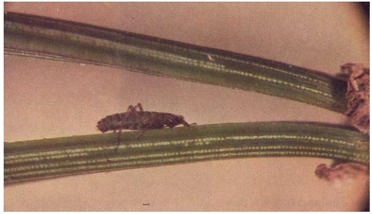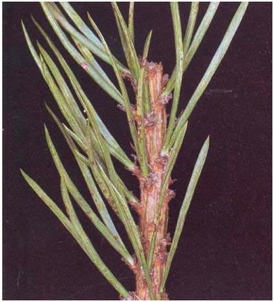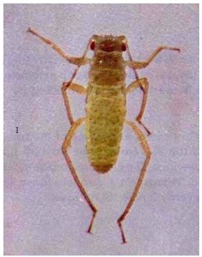PESTS AND DISEASES OF FORESTRY IN NEW ZEALAND
Pine Aphid Eulachnus brevipilosus
Scion is the leading provider of forest-related knowledge in New Zealand
Formerly known as the Forest Research Institute, Scion has been a leader in research relating to forest health for over 50 years. The Rotorua-based Crown Research Institute continues to provide science that will protect all forests from damage caused by insect pests, pathogens and weeds. The information presented below arises from these research activities.
Forest and Timber Insects in New Zealand No. 55: Pine aphid.
Revised 2009
Limited revision 2001
Based on R. Zondag (1983)
Insect: Eulachnus brevipilosus Börner (Hemiptera: Aphididae)

Fig. 1 - Pine aphid in typical feeding position between a needle pair and close to the needle sheath.
Host: Scots pine. Actual length 1.5mm.
Type of injury
The aphid Eulachnus brevipilosus sucks sap from twigs, shoots, and needles. Probe and feeding punctures turn yellow and then brown (Fig. 2), and needles may fall prematurely. Infested parts of a tree are slightly blackened by a soot fungus growing on honeydew excreted by the insects. Although over 200 aphids may occur on a shoot 150 mm long, trees with heavily attacked shoots look relatively healthy except for slight yellowing and the loss of 2- and 3-year-old needles.

Fig. 2 - The brown spots on these Scots pine needles are places where the pine aphid has been feeding.
Hosts
In New Zealand forests this aphid is known to attack numerous species of Pinus including Pinus radiata although it is not common on this host.
Distribution
This European insect was first found at Berwick Forest, Otago, in 1959. It now occurs throughout most of the country.
Economic importance
Although heavily attacked trees may suffer a reduction in growth rate, this insect is of little importance. The only trees on which noticeable damage occurs are Pinus densiflora (Japanese red pine), P. sylvestris (Scots pine) and P. mugo (Swiss mountain pine). These pines are not planted in great numbers in New Zealand.
Description, life history and habits
The insects are light green with small black spots on the upper surface, rather slender, soft bodied, and up to 1.5 mm long (Fig. 3). Like all aphids Eulachnus brevipilosus has stylet mouthparts which are inserted into plant tissues to suck out the sap. The adults can be either winged or wingless. The wingless form occurs throughout the year, but the winged ones, which are responsible for spreading infestations from tree to tree, have been observed only in November and April, when populations are greatest. This aphid can be easily mis-identified as Essigella californica (Forest and Timber Insects in New Zealand Leaflet No. 65).

Fig. 3 - Adult wingless pine aphid. Line shows actual length.
In spring the populations of aphids present on the needles and shoots which were formed in the previous year rapidly increase. After the buds flush some of the aphids move to the new foliage, but the majority remain on the older needles until the summer is well advanced. Individual aphids may be seen on twigs and needles but feeding is concentrated on the soft tissues on the inside of needles close to the needle sheath (Fig. 1).
Both winged and wingless female adults give birth to living female young: males have never been found in New Zealand. It is not known how many moults the young pass through to maturity or how long is taken from birth to adulthood. The generations overlap, but the number of generations occurring in a year has not been determined. The greatest numbers of aphids are present in November and April. This may be related to the greater abundance of predators in summer, or to high summer temperatures adversely affecting the reproduction rate of the aphid. It is also possible that the increase in sapflow or an improvement in its nutrient qualities in late spring and early autumn permit a larger population to exist at those times.
In Europe the winged and wingless forms produce in autumn a generation containing both males and females. These mate, and the females lay eggs which remain dormant over the winter. All the insects which hatch from the winter eggs are wingless females, which then give rise to the summer generations of winged or wingless females. This type of reproductive behaviour has not yet been recorded in New Zealand, and although aphid eggs have been found during winter in crevices of pine shoots and between needle sheaths it is not known if they are those of Eulachnus brevipilosus.
Control
Chemical control is not necessary since the damage caused by this insect is slight and can be ignored. Predatory insects apparently keep numbers down in summer, while in autumn the aphids are sometimes attacked by a fungal disease.
Known predators in New Zealand are adults and larvae of the two-spotted ladybird Adalia bipunctata (L.), and the eleven-spotted ladybird Coccinella undecimpunctata L.; larvae of the lacewings, Drepanacra binocula (Newman), Micromus tasmaniae (Walker), and Wesmaelius subnebulosus (Stevens) (Hemerobiidae); and unidentified hoverfly larvae (Syrphidae).
Bibliography
Zondag, R. 1983: Eulachnus brevipilosus Berner (Hemiptera: Aphididae). Pine aphid. New Zealand Forest Service, Forest and Timber Insects in New Zealand No. 55.
This information is intended for general interest only. It is not intended to be a substitute for specific specialist advice on any matter and should not be relied on for that purpose. Scion will not be liable for any direct, indirect, incidental, special, consequential or exemplary damages, loss of profits, or any other intangible losses that result from using the information provided on this site.
(Scion is the trading name of the New Zealand Forest Research Institute Limited.)

 Farm Forestry New Zealand
Farm Forestry New Zealand

